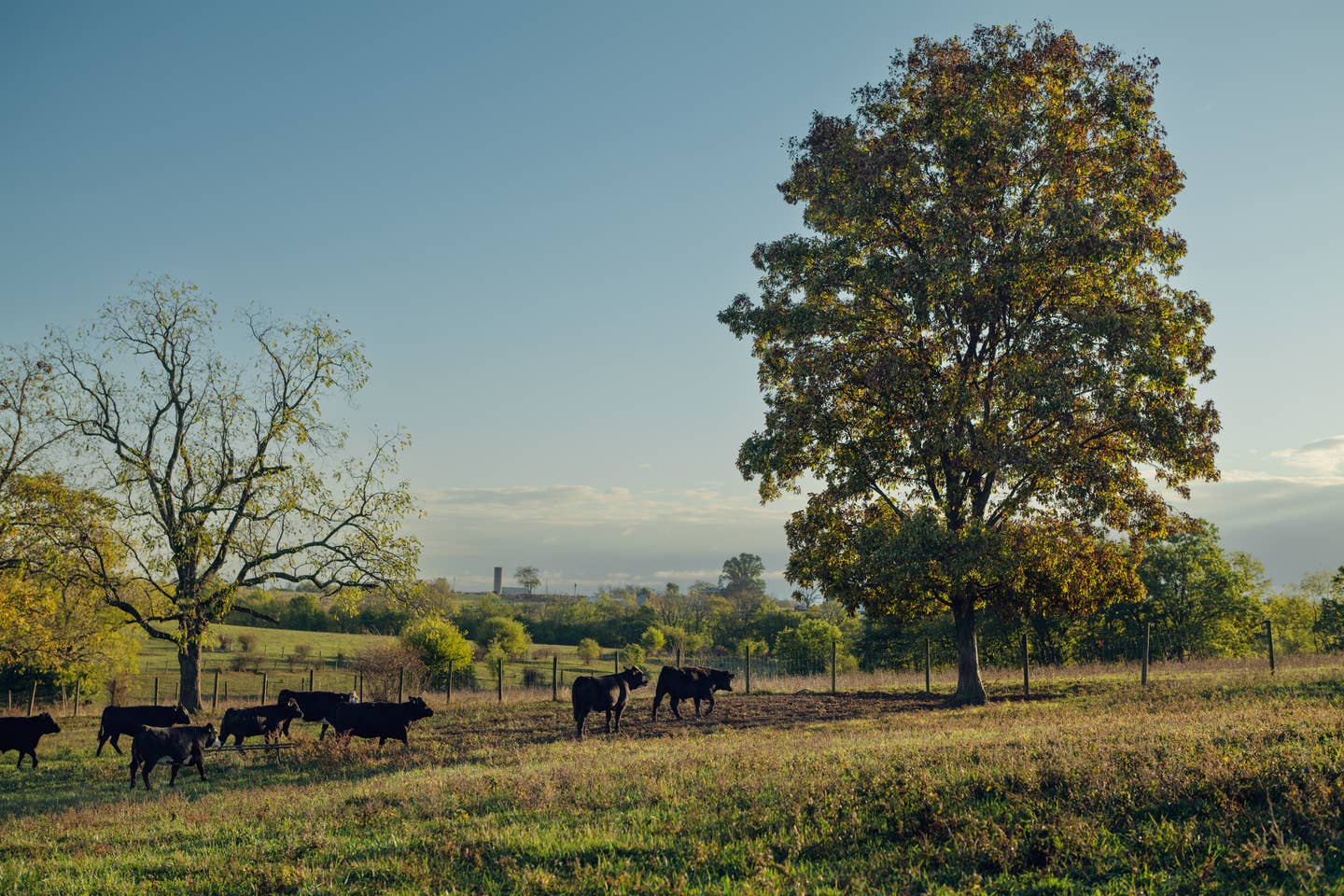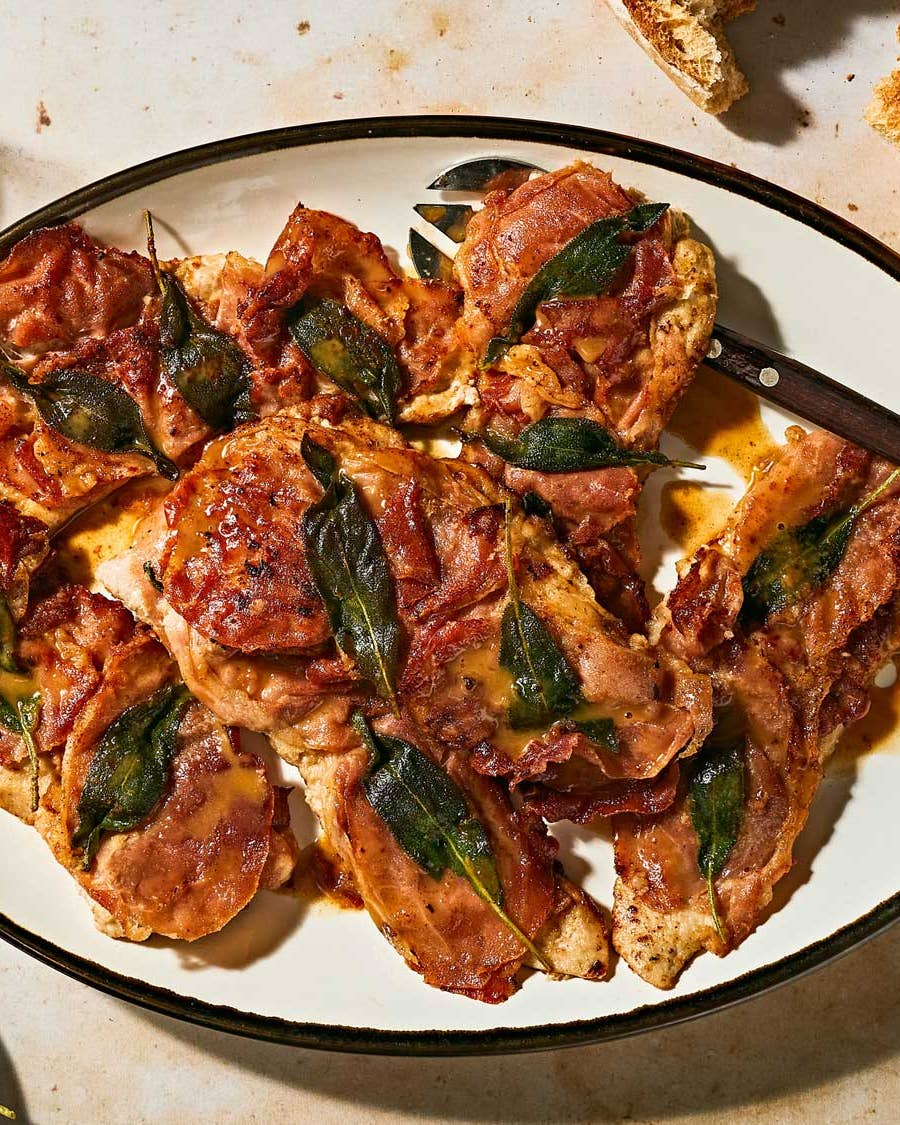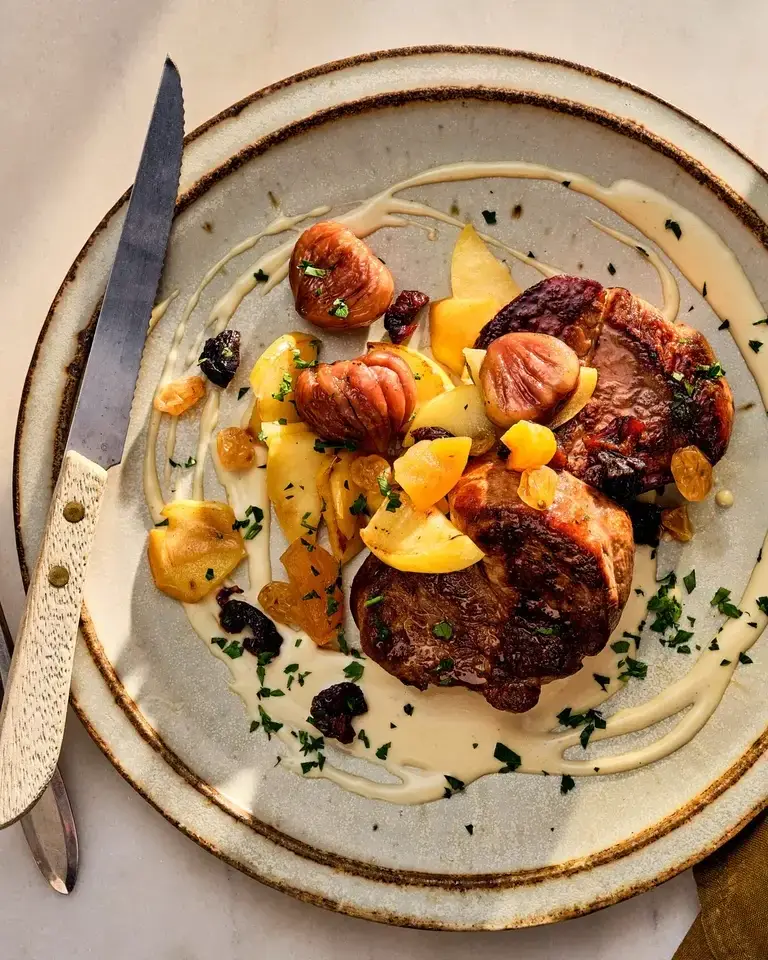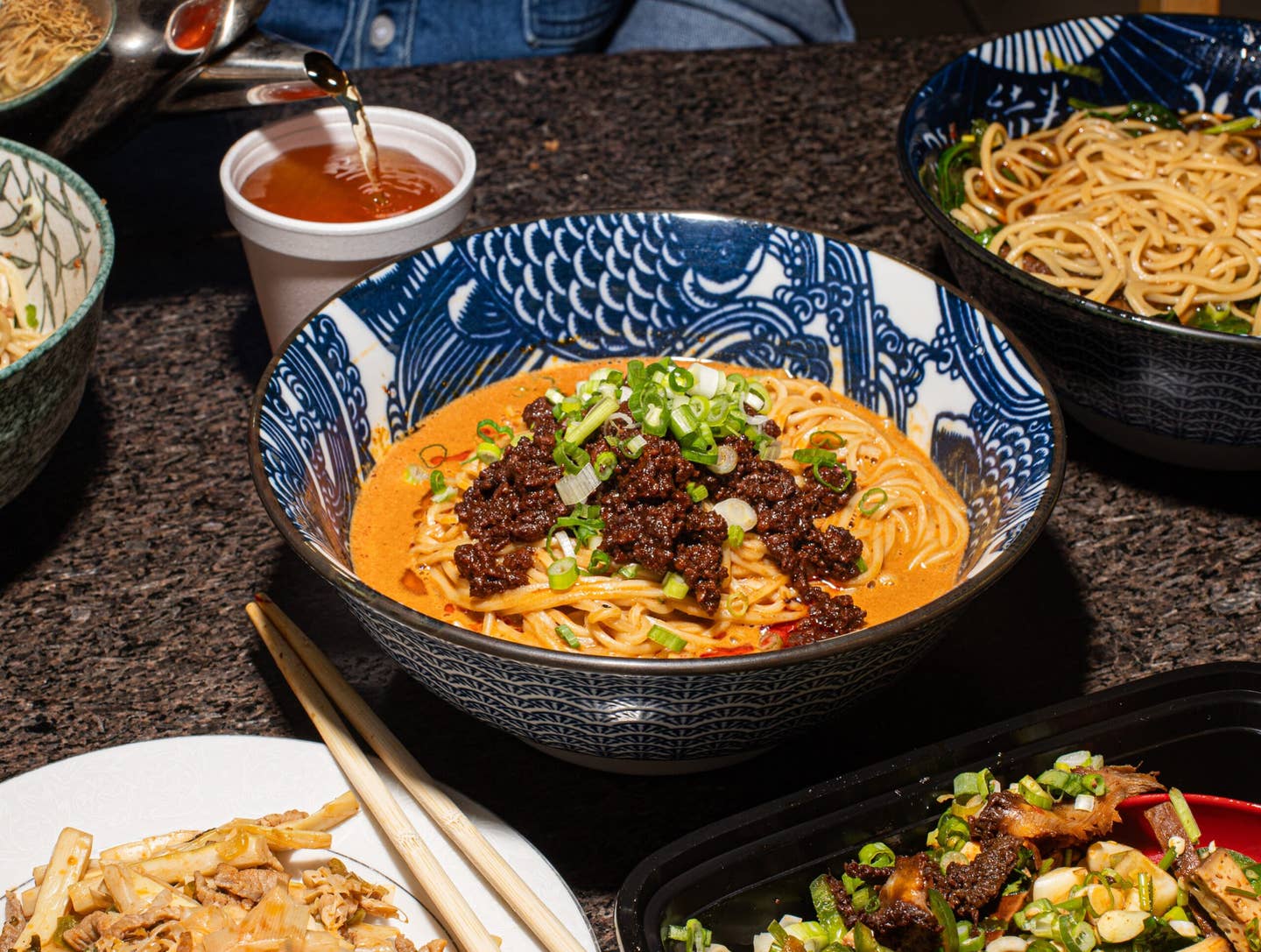
Veal’s Reputation Is Complicated—And Worth Reassessing
From the dairy farms of Maine to the beef cattle pastures of Kentucky, ethically raised rose veal is introducing the long-stigmatized meat to a new generation.
Standing at the window on her farm in Waldoboro, Maine, Allison Lakin watches her three Jersey bull calves—Frick, Frack, and Artie—play among a flock of starlings and butterflies on a grassy pasture nearby. It’s a Wednesday afternoon in September, and Lakin, owner of Lakin’s Gorges Cheese, is waiting for her pasteurization machine to reach the right temperature so she can get to work on her award-winning Rockweed and Cascadilla Bleu cheeses. Right now, though, the calves are keeping her entertained.
“They’re being so funny today,” she laughs, noting how they keep sticking their snouts in the dirt, playing peek-a-boo with the starlings. The scene sounds straight out of a Walt Disney movie, but there’s not much of a happy ending to this story. A few months from now, the trio of boisterous bovines will be sent off for processing and sold at Lakin’s farmstand as rose veal. As a cheesemaker, Lakin says she has always struggled with this part. The sad fact is that male calves are of little use to dairy farmers. They might keep one or two for breeding, but the rest, well, what can you do? Lakin doesn’t have the room nor the budget to raise the calves to adulthood for beef.
The way she sees it, though, this is simply a part of the holistic farming she and her husband, Neal, have embraced since opening their cheese-making business in 2011. Knowing their calves are being raised cruelty-free for rose veal, instead of the pale-white industrial stuff, gives her peace of mind.
If you’ve never heard of rose veal, you’re not alone. While it’s been widely known in Europe for years, it hasn’t made much of an impact here in the United States. Unlike traditional veal, which is often processed when calves are about six months old and weigh around 500 pounds, rose veal calves are processed at anywhere from eight months to a year, and weigh 600 to 1,500 pounds. Additionally, and crucially, rose veal calves are not confined to crates. They live their happy, albeit short, lives with their mothers on pastures eating a diet of milk, grass, and sometimes grain. While rose veal is darker than traditional veal—a product of a nutritious diet and active life—its beef flavor is almost as mild, the meat as tender as can be.
By these standards, rose veal should have great appeal to ethically minded consumers, but a stigma still surrounds it: After the Portland Press Herald wrote a story about Lakin’s rose veal program in 2017, she received pushback from the community, including hate mail and protesters showing up at her farm. This, despite the fact that the veal Lakin sells might be some of the most ethically and sustainably produced meat a conscientious eater could hope to find. Purchasing ethically sourced veal like Lakin’s might also increase demand, helping tip the broader dairy and veal industries toward more ethical practices overall. As a thoughtful consumer of meat and cheese, one might even consider it a responsibility to eat rose veal.
“By these standards, rose veal should have great appeal to ethically minded consumers, but a stigma still surrounds it.”
To animal rights activists, veal has long been the dirty little secret of the dairy industry. It can be a sticky point to the average omnivore, too. Images spring to mind of sickly calves torn from their mothers and tethered in crates, force-fed a diet of hormones and antibiotics just to sustain their short, miserable lives. When I mentioned to a friend a veal dish I tried while researching this story, his response wasn’t surprising: “Could you taste the torture?” he asked.
And yet veal is a necessary fact of our consumption of dairy. Female cows must bear calves in order to produce milk. Female calves can be raised as dairy cows, but most male calves born on dairy farms are regarded as surplus. Many are sold to feedlots just days after birth, where they will be raised for beef or veal. To meet the current demands of the American dairy industry, as problematic as it may be, it would be impossible to raise every single male calf to adulthood; the land and economy could simply not sustain it. And so there is veal.
Few meat-eaters balk at consuming other young animals like they do at calves—lambs and pigs, for example, are also generally slaughtered before they’re a year old. So how did veal come to earn its awful reputation? According to a 1985 article in the New York Daily News, “originally veal calves were raised in pastures with their mothers and their diet was milk and grass. Chefs looked for a pale color to make sure the veal was from a young calf, instead of the red beef from a more mature animal.”
But, in the 1950s, veal producers figured out they could get a perfectly pale-colored meat from older animals if, according to the Daily News, “the mature, heavier animals were made anemic on a diet low in iron. To decrease labor costs, these calves are kept indoors in slat-floored narrow crates, continuous confinement that leads to chronic stress requiring medication.” Preventing the calves from moving atrophied their muscles, ensuring a tender meat.
The tides shifted slightly in 1985, when word started circulating about something called Rambling Rose veal, a brand of grass-fed, free-range veal developed as a partnership between dairy farmers and a Chicago non-profit organization called the Food Animals Concern Trust (FACT). Formed in 1983 by the late animal rights activist Robert A. Brown, FACT was designed to prevent cruelty to animals used in food production. While a small number of chefs introduced Rambling Rose veal to their customers as a more ethically raised option in the mid-1980s, the program proved little more than a trend, and the Rambling Rose Brand trademark was retired in the early 1990s.
Traditional veal is still a thorny issue worldwide, though some progress has been made. The United Kingdom banned veal crates in 1990 and the European Union followed around 2006, but many European animal activists remain concerned about living conditions and diet.
In the U.S., several states have enacted veal crate bans that, according to the USDA, affect about 13 percent of the country’s veal production. The American Veal Association (AVA), which represents about 400 farmers, companies, and processors involved in veal production, has rolled out new ethical commitments over the years to address consumer concerns regarding mistreatment, including crate bans. Instead, calves reside in “group homes” inside open-air barns. According to the AVA’s website, practices such as castration, dehorning, tail docking, and tethers are not practiced on AVA member farms.
One might ask: Is there still a market for veal at all? I recently posed this question to my local butcher, Len Bleh, who owns Avril-Bleh Meats, a 130-year-old butcher shop in Cincinnati. In recent years, Bleh told me, most of his customers who buy veal are aged 60 or older. That tracks with national trends: According to the USDA’s Economic Research Service, Americans consumed only 0.3 pounds of veal per person annually in 2008, the last year figures were available. In 1944 it was 8.6 pounds per person. The last year Americans ate more than one pound of veal per person was 1988.
But demand for veal—and particularly rose veal—is showing signs of growth. That is thanks almost entirely to Mary Berry, daughter of Wendell Berry, the acclaimed writer, farmer, and conservationist, and one of the most famous proselytizers of ethically raised, sustainable food. In 2017, Mary Berry, with the support of her father, started Our Home Place Meat, a co-operative of small cattle farmers in Henry County, Kentucky, which might just be the current rose veal capital of America.
Our Home Place is part of the Berry Center, which seeks to put Wendell Berry’s writings to work by advocating for farmers, land-conserving communities, and healthy regional economies. The veal Our Home Place promotes doesn’t come from the dairy industry, but from Kentucky’s beef cattle industry. Selling veal calves directly to Our Home Place has given small cattle farmers a chance to put young calves to market without spending money on the out-of-state feedlots they once relied on to fatten their cows before processing. Instead, the calves are born, raised, and processed in Kentucky.
The program guarantees farmers receive a set price for their calves, despite market fluctuations, as long as they are raised by standards that take the animal’s welfare into account. It is loosely based on the Burley Tobacco Growers Co-Op, founded in 1941 by Mary Berry’s grandfather, John Berry Sr., which established parity pricing for tobacco so local farmers would no longer be gouged by the American Tobacco Company.
I drove to New Castle, Kentucky, to meet with Mary Berry, and to learn more about her efforts to promote rose veal as an ethical and sustainable meat. We met at New Castle Tavern, a neighborhood spot where I ordered what I can honestly say was one of the best cheeseburgers I’ve ever eaten. A burger, I later learned, made with ground rose veal.
In Kentucky, Mary Berry explained, calves typically stay with their mothers for six months until they’re weaned and shipped off to feedlots. “With rose veal,” she said, “you take the calf at weaning and harvest it then. For a farmer, that’s great, because you don’t have to carry those calves through winter. The only thing on your farm year-long are mama cows. You don’t need any more facilities, and you aren’t feeding the [younger cows] anything but grass.” By doing this, Our Home Place aims to cut out the need for industrial feedlots, allowing farmers to sustain their animals on their own land. Participating farmers must allow the calves to be pasture-raised with their mothers on a strict diet of milk and grass (no grain).
According to Bob Perry, who teaches sustainable agriculture and food systems at the University of Kentucky in Lexington, the rose veal produced through this program “is the most sustainably produced red meat possible.” But is sustainability enough to remove the decades-old stain from the American veal industry?
For farmer Clint Woods, it’s also a matter of livelihood. Woods has known the Berry family for most of his life: He went to school with Mary’s daughter and was part of Our Home Place’s pilot program in 2017. Since then, Woods and his wife, Alicia, have put about 80 yearlings through the rose veal program. He said he appreciates the financial certainty, as well as the center’s efforts to familiarize consumers of rose veal with the farmers who raise it.
“People will spend a couple extra dollars if they can see who [the veal] is coming from,” he said. I asked him how much the program was helping him to make ends meet. “I wouldn’t call it a home run,” he answered, “but it helped, for sure. I don’t know if it will solve everything. Sometimes you look at a big problem and you want to have big solutions, where a million little solutions is what’s needed.”
Recipes
Keep Reading
Continue to Next Story










